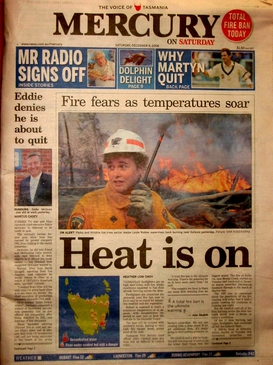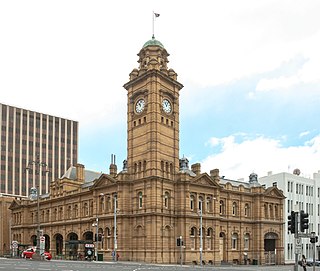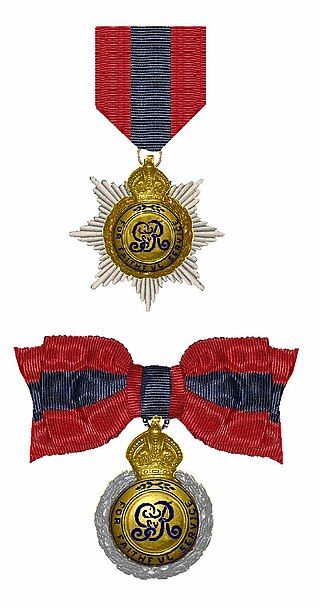Related Research Articles

Hobart is the capital and most populous city of the island state of Tasmania, Australia. Home to almost half of all Tasmanians, it is the southernmost and least-populated Australian state capital city, and second-smallest if territories are taken into account, before Darwin, Northern Territory. Hobart is located in Tasmania's south-east on the estuary of the River Derwent, making it the most southern of Australia's capital cities. Its skyline is dominated by the 1,271-metre (4,170 ft) kunanyi/Mount Wellington, and its harbour forms the second-deepest natural port in the world, with much of the city's waterfront consisting of reclaimed land. The metropolitan area is often referred to as Greater Hobart, to differentiate it from the City of Hobart, one of the seven local government areas that cover the city. It has a mild maritime climate.

Huon Valley Council is a local government body in Tasmania, covering most of the south of the state. Huon Valley is classified as a rural local government area and has a population of 17,219, towns and localities of the region include Cygnet, Dover, Franklin, Geeveston, Southport and the largest principal town, Huonville.
The education system in Tasmania comprises the education of children from their early years, through kindergarten, primary and high school, and tertiary education in universities and vocational education and training organisations. The system is delivered by the government-run K–12 schooling system, and numerous independent schools and colleges, most of which are controlled or sponsored by religious organisations. Public education in Tasmania is managed primarily by the Tasmanian Department of Education. The Department is responsible for all aspects of education in Tasmania including schooling, adult education, the State Library and TasTAFE, a vocational tertiary institution with many campuses around the state.

Hobart City Council is a local government body in Tasmania, covering the central metropolitan area of the state capital, Hobart. The Hobart local government area has a population of 53,684 and includes the suburbs of West Hobart, Lenah Valley, Mount Stuart, South Hobart, New Town, Sandy Bay and most of Fern Tree, North Hobart and Mount Nelson.

TheMercury is a daily newspaper, published in Hobart, Tasmania, Australia, by Davies Brothers Pty Ltd, a subsidiary of News Corp Australia, itself a subsidiary of News Corp. The weekend issues of the paper are called Mercury on Saturday and Sunday Tasmanian. The current editor of TheMercury is Craig Herbert.

Hamilton is a rural locality in the local government area (LGA) of Central Highlands in the Central LGA region of Tasmania. The locality is about 73 kilometres (45 mi) north-west of the city of Hobart. The 2016 census recorded a population of 241 for the suburb of Hamilton.

The Huon Valley, or simply the Huon, is a valley and geographic area located in southern Tasmania, Australia. The largest town is Huonville, with other smaller towns spread across the area. It includes Australia's most southern permanent settlement at Southport. The Huon Valley Council area had a population of 15,140 in 2011. Famed for its apple growing, the Valley was first settled by British colonists in the 1820s; prior to settlement the Huon Valley area was inhabited by the Mouheneenner, Nuenonne, Mellukerdee and Lyluequonny people.

The Tasmanian Museum and Art Gallery (TMAG) is a museum located in Hobart, Tasmania. The museum was established in 1846, by the Royal Society of Tasmania, the oldest Royal Society outside England. The TMAG receives 400,000 visitors annually.

Tasmanian Gothic is a genre of Tasmanian literature that merges traditions of Gothic fiction with the history and natural features of Tasmania, an island state south of the main Australian continent. Tasmanian Gothic has inspired works in other artistic media, including theatre and film.

Heather Rose is an Australian author born in Hobart, Tasmania. She is the author of the acclaimed memoir Nothing Bad Ever Happens Here. She is best known for her novels The Museum of Modern Love, which won the 2017 Stella Prize, and Bruny (2019), which won Best General Fiction in the 2020 Australian Book Industry Awards. She has also worked in advertising, business, and the arts.

Franklin Square is a 1.6-acre (0.63-hectare) oak-lined public square located in the Hobart City Centre in Tasmania, Australia. It is named for Sir John Franklin, an Arctic explorer and former Lieutenant-Governor of Van Diemen's Land. The centrepiece of the park is a statue of Franklin, with an epitaph written by Alfred, Lord Tennyson. As the city's most central urban parkland and transportation hub, Franklin Square is frequently utilised for festive markets, public gatherings and as a place for public protest.

Henry Hunter (1832–1892) was a prominent architect and civil servant in Tasmania and Queensland, Australia. He is best known for his work on churches. During his life was also at various times a state magistrate of Tasmania, a member of the Tasmanian State Board of Education, the Hobart Board of Health, a Commissioner for the New Norfolk Insane Asylum and President of the Queensland Institute of Architects.
Alan Cameron Walker (1865–1931) was an Australian architect and philanthropist, born in Hobart, Tasmania. The grandson of John Walker, he was educated at Hutchins School and apprenticed to Henry Hunter. He produced many Tasmanian government and other buildings during his career, and was also a keen silversmith, serving as President of the Tasmanian Arts and Crafts Society for 25 years. He was the first President of the Tasmanian Architect's Registration Board.

General Post Office is a landmark building located on the corner of Elizabeth Street and Macquarie Street in Hobart, Tasmania, Australia. It stands next to the former Mercury Building and has served as the headquarters of the Tasmanian Postal system since its construction in 1905, though mail processing has now been moved to Glenorchy.

St Mary's Cathedral in Hobart, Tasmania, Australia, is the seat of the Roman Catholic Archbishop of Hobart, presently Julian Porteous.

Ingle Hall is a landmark building in Hobart, Tasmania on the corner of Macquarie and Argyle Streets. It has served numerous purposes over its history and is vacant; it was most recently used as The Mercury print museum. It is unknown when the building was built as it predates any government record holding by the state of Tasmania, which began in 1822. It is named for John Ingle, one of the two possible first inhabitants of the building.

Isle of the Dead is an island, about 1 hectare in area, adjacent to Port Arthur, Tasmania, Australia. It is historically significant since it retains an Aboriginal coastal shell midden, one of the first recorded sea-level benchmarks, and one of the few preserved Australian convict-period burial grounds. The Isle of the Dead occupies part of the Port Arthur Historic Site, is part of Australian Convict Sites and is listed as a World Heritage Property because it represents convictism in the era of British colonisation.

William Nevin Tatlow Hurst, ISO was a senior Tasmanian civil servant. In 1925 he succeeded the Tasmanian Surveyor-General, E A Counsel, as the head of the Tasmanian Department of Lands and Surveys, although with the title of Secretary for Lands.

The State Cinema is a historic cinema venue located in North Hobart, Tasmania. It was acquired by the US-owned Reading Cinemas chain in November 2019.

The Odeon Theatre is a historic former cinema and live entertainment venue in the city of Hobart, Tasmania, Australia.
References
- ↑ Martain, Tim (5 August 2011). "Tasmanian gothic tempts Hollywood". The Mercury (Hobart). p. 21.
- 1 2 Thow, Penny (1 October 2011). "Dying for a black comedy". The Mercury (Hobart). p. 47.
- ↑ Martain, Tim (16 August 2014). "Scream queens". The Mercury (Hobart). p. 4.
- ↑ Kidd, Briony (13 November 2010). "All about bums on seats". The Mercury (Hobart). p. 29.
- ↑ Thow, Penny (17 September 2011). "Invasion of privacy". The Mercury (Hobart). p. 51.
- ↑ Peck, Damien (4 June 2015). "Art for everyone: Tasmanian arts community launches contemporary podcast". ABC News. Retrieved 9 August 2018.
- ↑ Thow, Penny (9 June 2016). "Mind how you go in the dark". The Mercury (Hobart). p. 30.
- ↑ "Tasmanian theatre so fresh its raw". Mercury. 20 March 2015.
- ↑ "Radio Gothic | Salamanca Arts Centre". www.salarts.org.au. Retrieved 9 August 2018.
- ↑ Abey, Duncan (12 June 2017). "Fright and sound". The Mercury (Hobart). p. 5.
- ↑ Kidd, Briony (24 November 2016). "How Tasmania became the gothic muse of Australian film and TV". the Guardian. Retrieved 9 August 2018.
- ↑ Kidd, Briony (14 July 2015). "Reading between the credits for Australian women directors". SBS Movies. Retrieved 9 August 2018.
- ↑ Kidd, Briony (10 June 2016). "Studio Ghibli's slight on female directors ignores the women who've made it great". SBS Movies. Retrieved 9 August 2018.
- ↑ Kidd, Briony (3 August 2018). "Matthew Newton is directing Jessica Chastain's next film. Should the road back really be this short? (Opinion)". SBS Movies. Retrieved 9 August 2018.
- ↑ Vowles, Gill (24 February 2008). "Filmmaker credits success to support". Sunday Tasmanian (Hobart).
- ↑ "August 2001 | Screen Tasmania". www.screen.tas.gov.au. Archived from the original on 28 August 2018. Retrieved 9 August 2018.
- ↑ "April 2003 | Screen Tasmania". www.screen.tas.gov.au. Archived from the original on 28 August 2018. Retrieved 9 August 2018.
- ↑ "July 2004 | Screen Tasmania". www.screen.tas.gov.au. Archived from the original on 28 August 2018. Retrieved 9 August 2018.
- ↑ "Short Drama Initiative 2009 | Screen Tasmania". www.screen.tas.gov.au. Archived from the original on 28 August 2018. Retrieved 9 August 2018.
- ↑ "2011-12 Financial Year | Screen Tasmania". www.screen.tas.gov.au. Archived from the original on 28 August 2018. Retrieved 9 August 2018.
- ↑ "2013-14 Financial Year | Screen Tasmania". www.screen.tas.gov.au. Archived from the original on 28 August 2018. Retrieved 9 August 2018.
- ↑ "2015-16 Financial Year | Screen Tasmania". www.screen.tas.gov.au. Retrieved 9 August 2018.
- ↑ Annual Report 2015/2016 (PDF). Screen Australia. 2016. p. 72. ISSN 1837-2740.
- ↑ "Motel at the End of the World - Screen Australia". Screen Australia. Retrieved 9 August 2018.
- ↑ Hope, Emma (16 July 2016). "Funding a screen saver for women". The Mercury (Hobart). p. 17.
- ↑ Barker, Alicia (12 December 2015). "Filmmakers in spotlight". The Examiner. Retrieved 9 August 2018.
- ↑ Stedman, Michael (27 October 2009). "Bid to save building goes online". The Mercury (Hobart). p. 13.
- ↑ "Ten Murray redevelopment heads for court". Australian Broadcasting Corporation (ABC) News. 15 March 2011.
- ↑ Brown, Damien (4 March 2010). "Push to save 10 Murray Artists organise exhibition in praise of high-rise block". The Mercury (Hobart). p. 21.
- ↑ "Aird steps in over Square knock-back". Australian Broadcasting Corporation (ABC) News. 8 July 2010.
- ↑ Neales, Sue (8 July 2010). "Parliament precinct project scuttled It's back to square one Project back to square one". The Mercury (Hobart). p. 1.
- ↑ "Parliament Square redevelopment clears last hurdle". Australian Broadcasting Corporation (ABC) News. 2 December 2011.
- ↑ "Appeal to save building". The Mercury (Hobart). 23 December 2011. p. 9.
- ↑ "Tasmania's Top 10 2012 Movers & Shakers". The Mercury (Hobart). 29 December 2012. p. 36.
- ↑ Fitzgibbon, Rebecca (17 February 2012). "A horrifying sexual revolution". The Mercury (Hobart). p. 42.
- ↑ Wilson, Jake (25 April 2016). "Women make a scene on the horror film circuit - and everyone should be afraid". The Sydney Morning Herald. Retrieved 9 August 2018.
- ↑ Watts, Richard (15 June 2018). "The waning shadow of the Tasmanian Gothic". ArtsHub Australia. Retrieved 9 August 2018.
- ↑ "Interview with Briony Kidd, Stranger With My Face Film Festival". Radio National. 7 April 2016. Retrieved 9 August 2018.
- ↑ Hope, Emma (23 November 2013). "Hobart horror among the best in film fests". The Mercury (Hobart). p. 9.
- ↑ "Stranger With My Face is on hiatus — Stranger With My Face". www.strangerwithmyface.com. Retrieved 9 August 2018.
- ↑ Kidd, Briony (24 November 2013). "Abortion in Tasmania is decriminalised, but it wasn't an easy battle | Briony Kidd". the Guardian. Retrieved 9 August 2018.